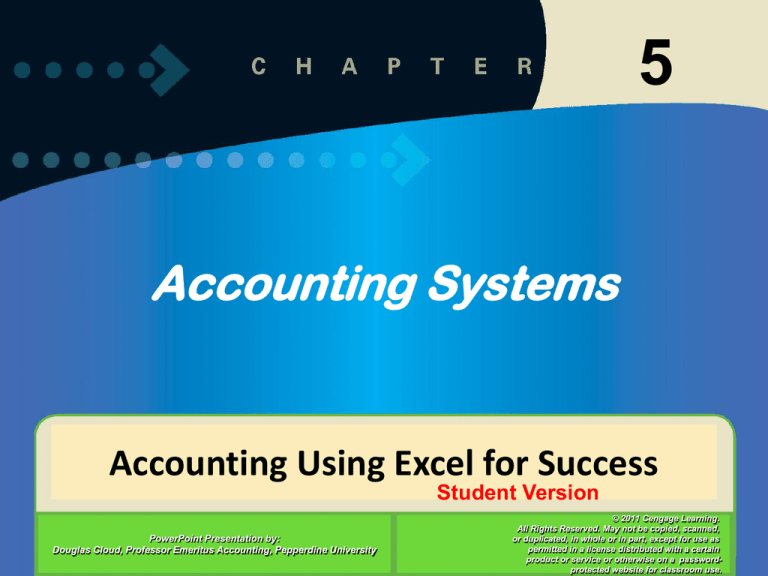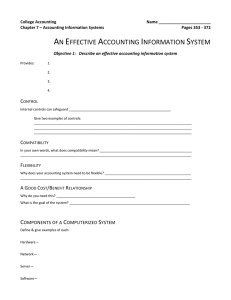
5
Accounting Systems
Accounting Using Excel for Success
5-1
PowerPoint Presentation by:
5-1
Douglas Cloud, Professor Emeritus Accounting, Pepperdine University
Student Version
© 2011 Cengage Learning.
All Rights Reserved. May not be copied, scanned,
or duplicated, in whole or in part, except for use as
permitted in a license distributed with a certain
product or service or otherwise on a passwordprotected website for classroom use.
1
1
Define and describe an
accounting system.
5-2
5-2
2
1
Accounting System
An accounting system is the
methods and procedures for
collecting, classifying,
summarizing, and reporting
a business’s financial and
operating information.
5-3
5-3
3
1
As a business grows and changes,
accounting systems also change in
the following three-step process:
• Step 1. Analyze user information
•
•
5-4
5-4
needs.
Step 2. Design the system to meet
the user needs.
Step 3. Implement the system.
4
1
Feedback
Once a system has been
implemented, feedback,
or input from the users
of the information can
be used to analyze and
improve the system.
5-5
5-5
5
1
Internal Controls
Internal controls are policies and
procedures that protect assets
from misuse, ensure that business
information is accurate, and
ensure that laws and regulations
are being followed.
5-6
5-6
6
1
Processing Methods
Processing methods are the means
by which the system collects,
summarizes, and reports
accounting information. These
methods may be either manual or
computerized.
5-7
5-7
7
2
Journalize and post
transactions in a manual
accounting system that uses
subsidiary ledgers and
special journals.
5-8
5-8
5-8
8
2
Subsidiary Ledger
A large number of individual
accounts with a common
characteristic can be grouped
together in a separate ledger
called a subsidiary ledger.
5-9
5-9
9
2
General Ledger
The primary ledger, which
contains all of the balance
sheet and income statement
accounts, is called a general
ledger.
5-10
5-10
10
2
Controlling Account
Each subsidiary ledger is
represented in the general
ledger by a summarizing
account, called a controlling
account.
5-11
5-11
11
2
The individual customers’ accounts
are arranged in alphabetical order in a
subsidiary ledger called the accounts
receivable subsidiary ledger or
customers ledger.
5-12
5-12
12
2
The individual creditors’ accounts
are arranged in alphabetical order in
a subsidiary ledger called the
accounts payable subsidiary ledger,
or creditors ledger.
5-13
5-13
13
2
Special Journal
Each special journal
is designed to be used
for recording a single
kind of transaction
that occurs frequently.
5-14
5-14
14
2
Special Journals
SELLING
Providing services on account
recorded in
Revenue Journal
Receipt of cash from any source
recorded in
5-15
5-15
Cash Receipts Journal
15
2
Special Journals
BUYING
Purchase of items on account
recorded in
Purchases Journal
Payment of cash for any purpose
recorded in
5-16
5-16
Cash Payments Journal
16
2
General Journal
The all-purpose two-column
journal, called the general journal
or simply the journal can be used
for entries that do not fit into any
of the special journals.
5-17
5-17
17
2
Other Special Journals
The revenue journal is used for
recording fees earned on account.
Cash fees earned would be recorded
in the cash receipts journal.
5-18
5-18
18
2
Exhibit 2
5-19
5-19
Revenue Journal
19
2
Exhibit 3
Revenue Journal
Postings to Ledger
5-20
5-20
20
2
Cash Receipts Journal
All transactions that involve the
receipt of cash are recorded in a
cash receipts journal. Every entry
recorded in the cash receipts
journal will involve a debit to the
“Cash Dr.” column.
5-21
5-21
21
2
Exhibit 4
Cash Receipts
Journal and
Postings
5-22
5-22
22
2
Accounts Receivable—(Controlling)
Balance, March 1, 2010
Total debits (from revenue journal)
$3,400
9,600
Total credits (from cash receipts journal)
(7,350)
Balance, March 31, 2010
$5,650
NetSolutions’ Accounts Receivable Subsidiary Ledger
Customer Balance Summary Report, March 31, 2010
Accessories By Claire
RapZone
Web Cantina
Total accounts receivable
5-23
5-23
$3,000
0
2,650
$5,650
23
2
Purchases Journal
The purchases journal is
designed for recording
all purchases on account.
5-24
5-24
24
2
Exhibit 5
Purchases
Journal and
Postings
5-25
5-25
25
2
Cash Payments Journal
All transactions involving a credit
to Cash are recorded in the cash
payments journal.
5-26
5-26
26
2
Exhibit 6
Cash Payments
Journal and
Postings
5-27
5-27
27
2
Accounts Payable Control
Account and Subsidiary Ledger
Accounts Payable (Control)
Balance, March 1, 2010
Total credits (from purchases journal)
Total debits (from cash payments journal)
Balance, March 31, 2010
$1,230
6,230
(5,050)
$2,410
NetSolutions
Supplier Balance Summary Report
March 31, 2010
Donnelly Supplies
Grayco Supplies
Howard Supplies
Jewett Business Systems
Total
5-28
5-28
$1,450
0
960
0
$2,410
28
3
Describe and give
examples of other
subsidiary ledgers and
modified special journals.
5-29
29
3
A business may modify its
special journals by adding
one or more columns for
recording transactions that
occur frequently.
5-30
5-30
30
3
Nov. 2 NetSolutions issued Invoice No.
842 to Litten Company for
$4,770, which included sales
taxes of $270.
3 Issued Invoice No. 843 to
Kauffman Supply Company for
$1,166, which included sales
taxes of $66.
5-31
5-31
31
3
Modified Special Journal
5-32
5-32
32
4
Describe and illustrate
the use of a
computerized
accounting system.
5-33
5-33
5-33
33
4
Computerized
Accounting System
1. Computerized systems simplify the
record-keeping process in that
transactions are recorded in electronic
forms and, at the same time, posted
electronically to general and subsidiary
ledger accounts.
5-34
5-34
34
4
2. Computerized systems are generally more
accurate than manual systems.
3. Computerized systems provide
management with current account balance
information to support decision making,
since account balances are posted as the
transactions occur.
5-35
5-35
35
4
Exhibit 7
5-36
5-36
Revenue and Cash Receipts in QuickBooks©
(continued)
36
4
Exhibit 7
5-37
5-37
Revenue and Cash Receipts in
QuickBooks© (continued)
37
5
Describe the basic
features of e-commerce.
5-38
5-38
38
5
e-Commerce
Using the Internet to
perform business
transactions is termed
e-commerce.
5-39
5-39
39
5
When transactions are
between a company and
a consumer, it is termed
B2C (business-toconsumer) e-commerce.
5-40
5-40
40
5
Three more advanced areas where the
Internet is being used for business
purposes are:
1. Supply chain management (SCM)
2. Consumer relationship management
(CRM)
3. Product life-cycle management
(PLM)
5-41
5-41
41
5-42
5-42
42




